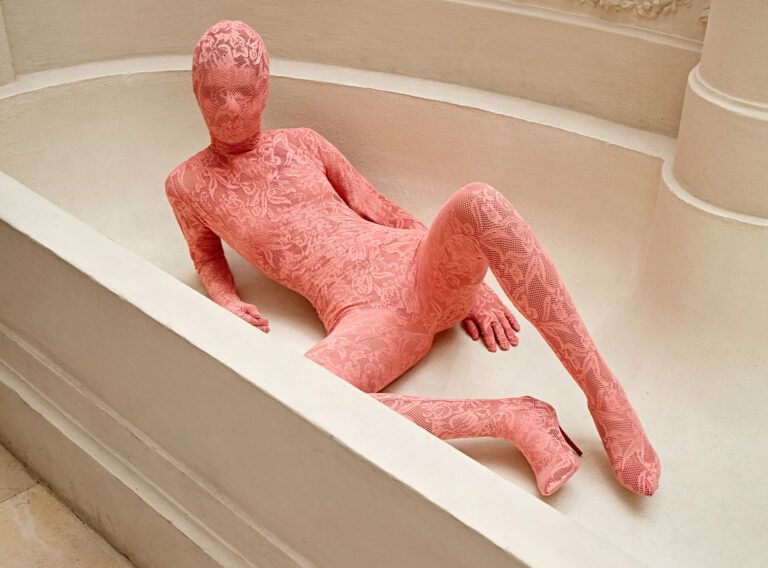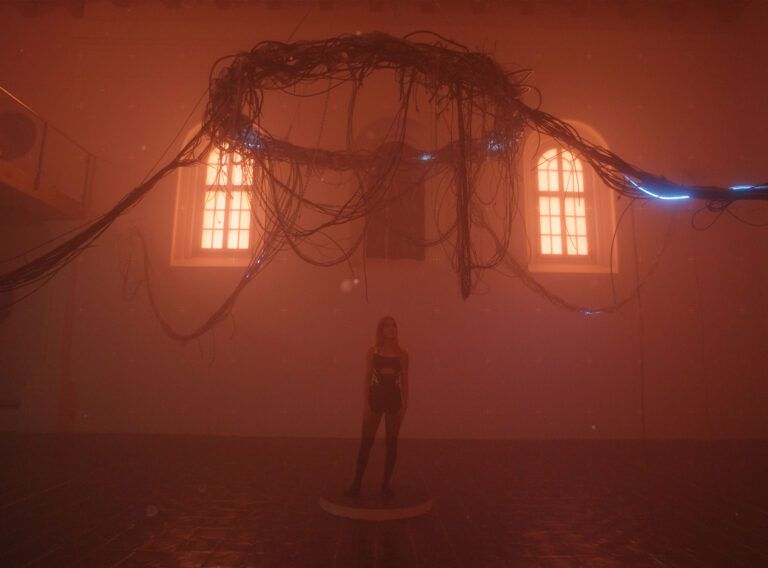The themes of motherhood, care, (eco)feminism, and the feminine principle are central to your work. How do you explore these themes, and what personal significance do they hold for you as an artist?
In art, I process what touches me the most, irritates me, and makes me express myself, to create. What has inspired me the most so far has been the exploration of my relationship with nature, myself, my surroundings, and in recent years, motherhood. Through motherhood one can look at everything. It encompasses love, care, self-reflection, shadow processing, relationships, roots and much more… simply everything that needs to be explored in our relationship to nature, to our existence. I observe that how we treat ourselves, how we raise our offspring, how we behave in interpersonal relationships, is how we approach our relationship with the non-human world. I actually garden my soul with art to be closer to symbiosis with nature and to understand my importance in society. Motherhood and ecology overlap, it’s basically one topic for me.

The installation highlights personal boundaries and the concept of guarding one’s own space while allowing for expansion. How do you explore these themes in your work, and what message or experience do you aim to convey to your viewers and participants?
The installation is called Skálopevný kraj (Adamant Country). The central motif is Petra – a plant, mandorla, or vulva, guarding an egg. The mandorla defines the space for the sacred, protects, but in this case also expands through space like a climbing plant. Next to it is the Serpent looking, connected to the sun. The serpent carries a huge amount of meaning; for me, mainly the protection of home, knowledge, sexual energy and connecting with inner darkness, the shadow, which connects with the sun (consciousness) and thus can consciously and purposefully protect. Two Spheres of Love roll around – spheres woven during a workshop with Mothers Artlovers while discussing the mantra “I love and I am loved”. Petra was woven again in a family circle with the help of several generations of women in my family. The whole installation is a spatial drawing; one can walk through the momentary scenery of my soul. My current self-portrait that guards the core, whether a child I keep under my heart or some thought integrity, expanding through space, protected by a snake and love.


The installation also features an ostrich egg and connects with the motif of Easter. Could you explain the symbolism and meaning behind the egg, and how it ties into the broader themes of your work?
Straw inlay on an egg carries many meanings, it is a rich tradition full of symbols. It has fascinated me since I was a child. Through it, I have touched my ancestors, and at the same time I put a wish and a prayer for the future, protection and fertility. I am pregnant, and when the concept was created and I was learning the technique from Ms. Marcela Hrabovská, I was not pregnant yet. The importance of straw, which I have been working with in my installations for several years now, touches on themes of motherhood, fertility, as well as agriculture and care for the land. The whole thing is my personal prayer and form of self-acceptance. And as I mentioned earlier, motherhood overlaps with my environmental experience of reality. An egg can be a symbol of, for example, offspring, new life, the future, hope, immortality, the beginning of the world, resurrection, rebirth…



The installation contains elements that reflect a wish for healing, cleansing, and repair on a personal and planetary scale. How do you envision your art contributing to these wishes, and what role do you believe art plays in addressing these pressing issues?
Perhaps by making the themes visible, manifesting them into reality – they can then touch the viewer. And somehow I believe that by processing the topic and taking it a step further, expanding my window of reality and perception, I will be a better mother to both my children and my greenhouse.
I think art can materialize, draw attention, and also open and expand consciousness. But what I want to avoid is imposing my unwavering worldview through ego, anger or fear. That’s why I have chosen the path of introspection until now, somehow sweeping my own doorstep and hoping it will help future generations.


As an artist, what challenges and rewards do you encounter when working with such profound and multi-layered themes in your art, and how have these themes evolved in your recent work compared to your earlier pieces?
Up until now, I’ve conceived of my art in a very ritualistic way and in many layers, with many rewards. The main ones have been personal growth, deep experiences for myself and the audience during performance, opening up discussions, intensive workshops, deep insights, creating communities and associations like Artbiom or artstudio Lůno, powerful experiences, and I think change as well. But honestly it’s an extremely exhausting way of working. That brings me to the topic of personal boundaries. I think I’ve built up the layers gradually and I kind of feel like I’m going to peel back the layers again now.



Petra Janda’s art project is part of the Jindřich Chalupecký Award 2023 exhibition opening on November 1st at PLATO Ostrava, Bauhaus, together with artworks by the laureates Kryštof Brůha, Lenka Glisníková, Gabriela Těthalová and the artist collective StonyTellers.
Opening: 1.11. 6PM Exhibition: 2.11.2023 – 25.2.2024 Plato Bauhaus, Janáčkova 22, Ostrava




